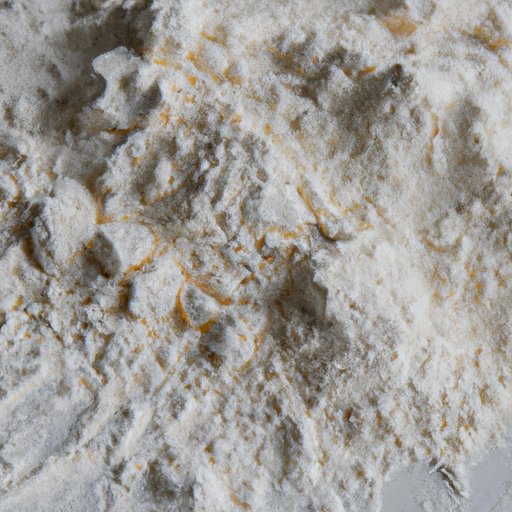
Introduction
Have you ever found an old bag of flour buried in the back of your pantry? Maybe it’s been there for a while, and you’re not sure if it’s still good. Using expired flour can be risky, but it’s not always a lost cause. In this article, we’ll explore whether it’s safe to use expired flour, tips for maximizing its shelf life, creative uses for expired flour, and recipes that reduce food waste.
Can You Use Expired Flour in Baking?
The safety concerns of using expired flour for baking come from potential contamination with bacteria, mold, or pests. Old flour also loses its moisture and can cause baked goods to become dry and tasteless. However, not all expired flour is harmful, and it can still be used in some instances.
Before using expired flour for baking, it’s essential to check its appearance, smell, and texture. Discard flour if it has a sour or musty odor, appears discolored with a grayish or yellow tint, or has a clumpy or lumpy texture. These are all signs of spoilage, and they indicate that the flour is no longer safe for consumption.
If your flour looks and smells fresh, you can still use it to make non-yeast recipes like pancakes, waffles, or quick bread. Just remember that the final product may not be as flavorful or rise as well as it would with fresh flour.
Maximizing Flour’s Shelf Life
Proper storage can help maximize the shelf life of your flour. Store flour in a cool, dry, and dark place, such as a pantry or cupboard. Humidity and moisture are the enemies of fresh flour, so keep it away from sources of moisture like heat, light, and air.
Do not store flour in its original paper packaging, as it is not airtight, and it can quickly accumulate moisture, leading to spoilage. Instead, transfer the flour to an airtight container, like a glass or plastic jar with a tight-fitting lid. This way, you can extend the shelf life of your flour by up to six months, or even longer if you store it in the freezer.
Creative Uses for Expired Flour
Instead of throwing away expired flour, consider using it for alternative purposes. Flour has absorbent qualities, making it a great cleaning agent. Use it to clean up spills or to shine your silverware. You can mix expired flour with water to create a paste and use it as a natural scrubbing agent for your sink and bathtub.
Expired flour also makes an excellent DIY play dough for kids. Mix flour, salt, water, and food coloring to create a fun and safe activity for kids to play with. And, of course, if your flour is just a bit past its prime, you can still use it to make non-baked goods like homemade playdough, or add it to your compost pile.
The Importance of Checking Expiration Dates
Checking expiration dates is crucial for ensuring that the food you consume is safe and healthy. Expired flour can lead to food poisoning or spoilage, which can cause stomach upset, vomiting, and diarrhea.
In addition to the safety concerns, using expired flour can affect the quality of your baked goods. Older flour loses its flavor and baking power, which can impact the final product’s texture and taste.
Recipes to Use Up Expired Flour
If you still have some expired flour that you’re not quite sure what to do with, try some of these recipe ideas:
- Homemade Play Dough: Mix two cups of flour, one cup of salt, one tablespoon of oil, and a half cup of warm water. Add food coloring for fun.
- Bath Bombs: Mix one cup of flour, one cup of Epsom salt, one cup of citric acid, and one cup of baking soda. Mix in essential oils and dried flowers for scent and color.
- Birdseed Cakes: Mix one cup of expired flour with one cup of birdseed, 1/4 cup of honey and 1/2 cup of water. Pour the mixture into a shape of your choice and let it dry for at least 24 hours. Hang it on a branch, and watch birds come flocking.
The Science of Flour Expiration
Flours all have a limited shelf life, which is about 6-9 months for wheat flour and 3-6 months for whole wheat flour because they contain bran and germ, which make them prone to rancidity. As wheat flour ages, it lengthens the gluten strands, making it more difficult for the gluten to hold onto air bubbles, resulting in a reduced rise. The flour’s moisture decreases, which can cause the flour to clump, making it difficult to work with in recipes.
The effects of aging flour can be minimized by reducing exposure to air, light, and moisture. Proper storage is essential for getting the most out of your flour.
How to Tell Fresh Flour from Expired Flour
Checking your flour’s expiration date is the simplest way to ensure it’s fresh and safe for consumption. When it comes to expired flour, checking its qualities, particularly by looking at its color, odor, and texture, is the best way to determine whether it can be used. Fresh flour should have a light color, a neutral odor, and be a powdery, smooth texture. If you notice any off colors, smells or there are hard clumps or lumps present, your flour may have expired.
Conclusion
Expired flour doesn’t have to be thrown away immediately as it can still be put to good use. Additionally, it’s worth monitoring how you store your flour, especially given its shelf life, to ensure it remains in good quality for as long as possible. Whether you opt to use the flour for baking, cleaning, or DIY projects, following safety precautions while acknowledging the dangers of using expired flour should be a priority.




